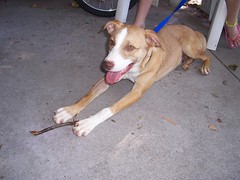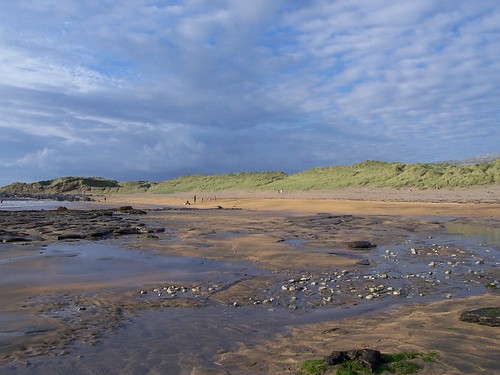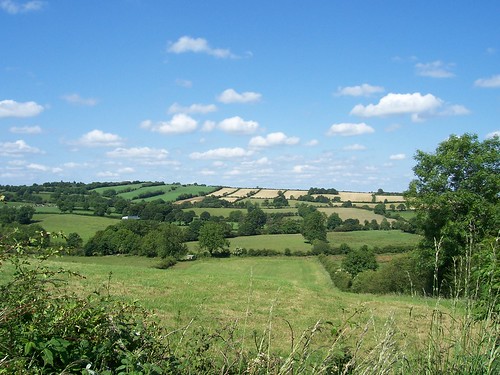Training
I’m learning a few things from dog training that’s making me think about the ways I’ve been training my kids:
1. Let them know that you’re the “Alpha dog” and that they need to obey you. When I first became a parent, I figured I wanted my children to question things like bad government policies when they become adults, so I let them question my policies. Of course, I now have children who are independent thinkers and good arguers, skills I may be proud of when Megan wins a case before the Supreme Court, but which are currently rather annoying. Since I don’t need another family member giving me a hard time, and since I’m not that concerned about the dog’s creative expression, I’m asserting my authority with the pup. I say, “Spud, crate!” and he goes in. It’s very gratifying.
2. Dog trainers emphasize that you should only say the dog’s name once when giving a command. They explain that if you say, “Spud, Spuud, Spud! SPUD!” the dog will not learn that his name is Spud. He’ll learn that his name is Spudspudspudspud, and he won’t respond until he hears his whole name. Likewise, if you say, “Sit, sit, sit! SIT!” he’ll either sit on the fourth command, or ignore you completely. I absolutely wished I had understood this before having children. On a typical morning I say, “Luke, get dressed” at least four times before he actually does it. He certainly seems to think that his name is “Lukelukelukeluuuuke!”
3. Don’t reward barking. I’m very proud of myself for resisting the impulse to run and rescue Spud on the few occasions when he’s barked to get out of his crate. On Friday, for example, when I was franticly packing to get out of town, he sensed something was up and started yelping. But I steeled myself, ignored him, and he quieted down. In contrast, when Megan was born, I was convinced that her emotional and spiritual health depended on my jumping at every whimper. I wanted her to trust God and the universe, so I worked hard to meet her every need. I still believe in responding to our baby’s needs, but somehow I now have a nine-year-old who thinks she needs a cell phone. In hindsight, a little delayed gratification earlier in life might not have been such a bad thing.
4. A well exercised dog will be better behaved. One of the gifts Spud is giving us is the habit of walking as a family. Tom and I have often said, “Let’s take a walk after dinner,” a suggestion that has usually been poorly received. Now we have no choice, so our little troop is getting out and about, getting exercise, meeting the neighbors, and appreciating how many birds and squirrels live in our city (since Spud tries to chase every bird or squirrel). Although walking adds one more thing to our schedule, I think it has a calming effect on all of us.
5. Keep the dog in his crate while house training and beyond. Dog trainers say that dogs feel safe in their crates, which are like private dens. They also keep puppy from eating the couch, which is generally good for the dog/owner relationship. Dare I say how tempting it would be to get Luke a crate?
But here the differences between raising a dog and raising a boy become inescapable. I’m preparing Spud for a life of napping and following orders. I want him to be content and healthy, but if chewing on the couch is his deepest desire—well, tough. Of course, there are people who spend their lives napping and following orders, maybe even a majority of Americans from the current look of things. Our democracy is being dismantled and our children are being sent off to kill and die in a war that was a mistake to begin with. But most Americans are napping in their crates, having learned that their barking will be ignored. I don’t know whether to blame our parenting or our politicians, but it seems someone taught us obedience a bit too well.
Unlike Spud, Luke will eventually leave my home and venture out into a world of possibilities, some of them pretty scary. He’ll need to be able to walk alone, express his needs, argue for what he thinks is right, and trust in God. Temping as it is, I don’t think putting him in a crate (physically or metaphorically) will help him in the long run. With that in mind, I’ll continue to give him a long leash and get my short-term satisfaction from having an obedient dog.
1. Let them know that you’re the “Alpha dog” and that they need to obey you. When I first became a parent, I figured I wanted my children to question things like bad government policies when they become adults, so I let them question my policies. Of course, I now have children who are independent thinkers and good arguers, skills I may be proud of when Megan wins a case before the Supreme Court, but which are currently rather annoying. Since I don’t need another family member giving me a hard time, and since I’m not that concerned about the dog’s creative expression, I’m asserting my authority with the pup. I say, “Spud, crate!” and he goes in. It’s very gratifying.
2. Dog trainers emphasize that you should only say the dog’s name once when giving a command. They explain that if you say, “Spud, Spuud, Spud! SPUD!” the dog will not learn that his name is Spud. He’ll learn that his name is Spudspudspudspud, and he won’t respond until he hears his whole name. Likewise, if you say, “Sit, sit, sit! SIT!” he’ll either sit on the fourth command, or ignore you completely. I absolutely wished I had understood this before having children. On a typical morning I say, “Luke, get dressed” at least four times before he actually does it. He certainly seems to think that his name is “Lukelukelukeluuuuke!”
3. Don’t reward barking. I’m very proud of myself for resisting the impulse to run and rescue Spud on the few occasions when he’s barked to get out of his crate. On Friday, for example, when I was franticly packing to get out of town, he sensed something was up and started yelping. But I steeled myself, ignored him, and he quieted down. In contrast, when Megan was born, I was convinced that her emotional and spiritual health depended on my jumping at every whimper. I wanted her to trust God and the universe, so I worked hard to meet her every need. I still believe in responding to our baby’s needs, but somehow I now have a nine-year-old who thinks she needs a cell phone. In hindsight, a little delayed gratification earlier in life might not have been such a bad thing.
4. A well exercised dog will be better behaved. One of the gifts Spud is giving us is the habit of walking as a family. Tom and I have often said, “Let’s take a walk after dinner,” a suggestion that has usually been poorly received. Now we have no choice, so our little troop is getting out and about, getting exercise, meeting the neighbors, and appreciating how many birds and squirrels live in our city (since Spud tries to chase every bird or squirrel). Although walking adds one more thing to our schedule, I think it has a calming effect on all of us.
5. Keep the dog in his crate while house training and beyond. Dog trainers say that dogs feel safe in their crates, which are like private dens. They also keep puppy from eating the couch, which is generally good for the dog/owner relationship. Dare I say how tempting it would be to get Luke a crate?
But here the differences between raising a dog and raising a boy become inescapable. I’m preparing Spud for a life of napping and following orders. I want him to be content and healthy, but if chewing on the couch is his deepest desire—well, tough. Of course, there are people who spend their lives napping and following orders, maybe even a majority of Americans from the current look of things. Our democracy is being dismantled and our children are being sent off to kill and die in a war that was a mistake to begin with. But most Americans are napping in their crates, having learned that their barking will be ignored. I don’t know whether to blame our parenting or our politicians, but it seems someone taught us obedience a bit too well.
Unlike Spud, Luke will eventually leave my home and venture out into a world of possibilities, some of them pretty scary. He’ll need to be able to walk alone, express his needs, argue for what he thinks is right, and trust in God. Temping as it is, I don’t think putting him in a crate (physically or metaphorically) will help him in the long run. With that in mind, I’ll continue to give him a long leash and get my short-term satisfaction from having an obedient dog.


 So now it’s time to reflect on the trip and try to sum it up in a blog post.
So now it’s time to reflect on the trip and try to sum it up in a blog post. It was one of many towns in Ireland that vanished back into the bog, taking stories and ghosts with it.
It was one of many towns in Ireland that vanished back into the bog, taking stories and ghosts with it.